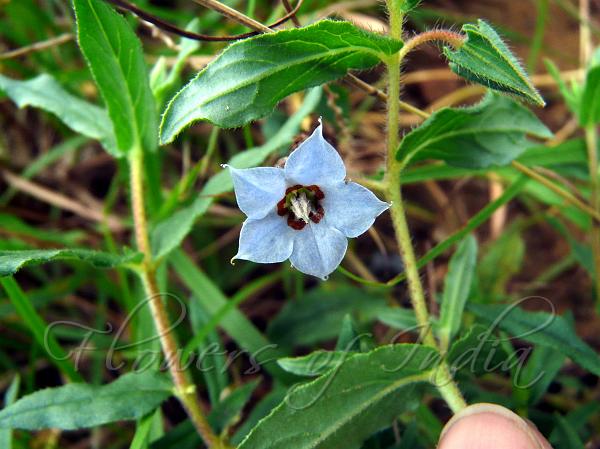|
| Indian Borage |
|

|

| File size | 791180 |
| Original date | 9/23/18 4:35 PM |
| Resolution | 2048 x 1536 |
| Flash | Flash did not fire, auto |
| Focal length | 4.6mm |
| Exposure time | 1/125s |
| Aperture | 3.2 |
| Focus Distance | |
| Metering Mode | Spot |
| Camera make | Panasonic |
| Camera model | DMC-FZ18 |
| Sensor type | OneChipColorArea |
|
|
|
Photo: |
Botanical name: Trichodesma indicum Family: Boraginaceae (Forget-me-not family)
Synonyms: Borago indica, Boraginella indica, Pollichia indica
Synonyms: Borago indica, Boraginella indica, Pollichia indica
This is an erect, spreading, branched, annual herb, about 50 cm in
height, with hairs springing from tubercles. The leaves are stalkless,
opposite, lanceshaped, 2-8 cm long, pointed at the tip, and
heart-shaped at the base. The flowers occur singly in the axils of the leaves.
The sepal tube is green, hairy, and 1-1.3 cm long, with pointed sepals.
The flower tube is pale blue or white, with the limb about 1.5 cm in diameter,
and the petals pointed. The fruit is ellipsoid, and is enclosed by the sepals.
The nutlets are about 5 mm long, and rough on the inner surface.
Indian Borage is found throughout India, on roadsides and stony dry wastelands.
It is found in the Himalayas and Western Ghats upto 1500 m elevation.
Medicinal uses: The plant is acrid, bitter in taste. In herbal medicine jargon, it is
thermogenic, emollient, alexeteric,
anodyne, anti-inflammatory, carminative, constipating, diuretic, depurative,
ophthalmic, febrifuge and pectoral. This herb is also used in arthralgia,
inflammations, dyspepsia, diarrhoea, dysentery, strangury, skin diseases and
dysmenorrhoea.
The plant is acrid, bitter in taste. In herbal medicine jargon, it is
thermogenic, emollient, alexeteric,
anodyne, anti-inflammatory, carminative, constipating, diuretic, depurative,
ophthalmic, febrifuge and pectoral. This herb is also used in arthralgia,
inflammations, dyspepsia, diarrhoea, dysentery, strangury, skin diseases and
dysmenorrhoea.
Medicinal uses:
 The plant is acrid, bitter in taste. In herbal medicine jargon, it is
thermogenic, emollient, alexeteric,
anodyne, anti-inflammatory, carminative, constipating, diuretic, depurative,
ophthalmic, febrifuge and pectoral. This herb is also used in arthralgia,
inflammations, dyspepsia, diarrhoea, dysentery, strangury, skin diseases and
dysmenorrhoea.
The plant is acrid, bitter in taste. In herbal medicine jargon, it is
thermogenic, emollient, alexeteric,
anodyne, anti-inflammatory, carminative, constipating, diuretic, depurative,
ophthalmic, febrifuge and pectoral. This herb is also used in arthralgia,
inflammations, dyspepsia, diarrhoea, dysentery, strangury, skin diseases and
dysmenorrhoea.| Identification credit: Nandan Kalbag, Navendu Pagé | Photographed in JNU, Delhi. |
• Is this flower misidentified? If yes,